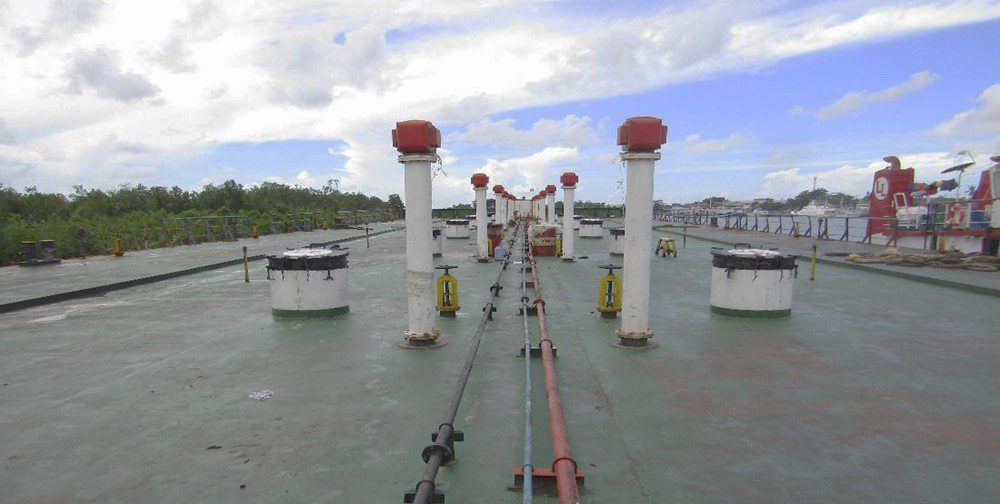Typical CPO tank barge main deck area layout
[as copied from the Kahuripan shortage report from Aurora]
Introduction
MM members who operate tug and tank barge units or self-propelled oil barges in the CPO bulk liquid trades are often faced with the problem of observed cargo shortages or losses based on a comparison between the load port and discharge port measured quantities. This Risk Bulletin is focussed on the identification of such losses as either ‘physical (real) losses’ or ‘paper (apparent) losses’, their causes and the prevention of associated cargo claims exposure and voyage delays.
Background
Cargo losses observed during the cargo tank gauging process by attending surveyors and vessel crew may be either ‘physical losses’ e.g. due to tank leakage or theft or ‘paper losses’ due to cargo measurement errors. Fortunately, ‘physical losses’ do not occur on a regular basis but the possibility should be considered and investigated in order to eliminate cargo leakage or theft as a likely cause of an observed shortage or loss. If the findings are that a ‘physical loss’ has not occurred, then the loss control focus must then shift to establishing the reason or reasons for a ‘paper loss’ and the prospective re-gauging of the cargo to establish a correct and agreed cargo figure.
The processes for assessing both ‘physical losses’ and ‘apparent losses’ are discussed below. However, we will first look at the barge owner’s/carrier’s legal obligation to deliver all of the cargo received on board and the partial reduction of this obligation which may be provided by the Customary Trade Allowance (CTA) i.e. the well-established bulk oil – 0.5% trade allowance.
NOTE: The amount of the CTA can reportedly vary between 0.3%, up to as much as 1.0%. The applicable allowance amount will depend upon the customs of the trade or the CTA amount agreed in writing by the parties.
Cargo Delivery Obligations and the CTA
The principal obligation of any carriage of goods by sea contract is that the cargo loaded on board will be delivered by the carrier to the discharge port in the same condition and in the same quantity as received on board at the load port. If this is not accomplished then, subject to the potential application of the applicable CTA, an in-transit loss and/or short delivery claim by vessel charterers and/or cargo consignees against the carrier will normally arise.
Members must keep in mind that the CTA may not always be allowed in law as a shortage partial defence for the carrier if it is not specifically incorporated into the carriage contract. Members should therefore ensure that a protective CTA clause is contained within both the Bill of Lading (B/L) and all Charterparty terms which are contractually incorporated into the B/L.
The wording of the CTA clause should preferably include the following Member protections:
- The maximum in-transit loss allowance will be – 0.5% of the total cargo loaded as applied to any proven difference between the net vessel cargo volumes or weights after loading at the loading port (ship’s figure after loading or SFAL) and before unloading at the discharge port (ship’s figure before discharge or SFBD).
- Any and all shortage claims made by the charterer and/or cargo consignees may only be made on the aforesaid basis and not by reference to the B/L figure at load port and shore tank outturn figure at the disport for which the carrier accepts no liability.
- Claim amounts must be based on the invoiced FOB cargo value at load port.
- No deductions of claim amounts from freight are permitted by the charterer unless expressly agreed in writing by the carrier.
CPO ‘Physical Losses’
As noted above, if a cargo shortage is observed, then the potential for ‘physical losses’ must always be investigated with the goal of eliminating it as a cause. The two main causes of such losses are usually:
- Cargo theft, with or without the knowledge of the tug and barge unit crew e.g. clandestine theft while a tank barge is under tow and its watchman is asleep. The prevention of theft is normally dissuaded by ensuring that all cargo system valves, lines and tank accesses are witnessed as being sealed with numbered seals at the load port and are later witnessed as all being intact on arrival at the disport. It is essential that these procedures are accomplished vigilantly and carefully recorded. This is because techniques for seal breaking and their hidden repair or replacement are now well developed.
- Accidental leakage from cargo tanks into the sea (e.g. due to tank corrosion and perforation) or into adjacent double bottom tanks, cofferdams or other void spaces (e.g. due to tank corrosion and perforation or leaking cargo tank manhole covers). CPO cargo leakage into the sea during the course of a voyage appears to be unusual but may be noticeable from visible oil traces. Cargo leakage into adjacent non-cargo spaces can only be determined by physically checking those spaces (by taking soundings or opening manholes) for any signs of CPO leakage.
CPO ‘Apparent Losses’
The precise measurement of bulk liquid cargoes in both shore tanks and vessel cargo tanks is subject to a number of factors which include the measurement accuracy of liquid levels, temperature and density as well as the calibrated accuracy of tank capacity tables and cargo density correction factors.
Errors and/or inaccuracies in any of these factors can produce an apparent voyage loss (ship load figure at departure [SFAL] to vessel load figure on arrival [SFBD]) and/or an apparent shore figure outturn loss (Bill of Lading [B/L]) shore tank figure at load port [STL] to shore tank figure at disport [STD] on completion of discharge).
As explained above, the inclusion of a comprehensive CTA clause into the carriage contract will restrict the apparent loss problem and shortage liabilities to a comparison between the vessel/ship load figure at departure [SLD] to the ship/vessel load figure on arrival [SLA]. Importantly, it will also provide a – 0.5% (or as agreed) protective allowance against potential measurement errors.
But what happens if measurement errors and a resultant ‘apparent loss’ exceed the applicable CTA ? If this occurs, then charterers and/or consignees will likely lodge a shortage claim. It is therefore necessary to look closely at the two most likely causes of an ‘apparent loss’ and ways in which these problems can be controlled.
- CPO Cargo Gauging Errors
The measurement of cargo levels inside the cargo tanks of barges is normally ascertained by measuring the depth of the cargo in the tank. This is done by taking a sounding of the tank using either. a ‘sounding tape’)i.e. a flexible steel tape fitted with a brass sounding bob) or what is known as a ‘sounding rod’ which is a long metal rod (made up of connectable sections) which is marked in metres and centimetres.
The sounding in each tank is then noted and later compared to tank sounding tables for each tank (as usually calibrated by the barge builder and endorsed by class) which provide a measure of the cubic meter volume of cargo in each tank. However, three potential sources of error which can affect the accuracy of tank soundings are:- The overall condition of the ‘sounding tape’ or ‘sounding rod’ being used has not been thoroughly and jointly checked by all of the attending parties to verify that all sounding devices are without damage, correctly assembled and accurately marked. Any defect could of course cause a measurement error across all cargo tanks.
- The tank sounding pipe is not located in the exact centre of the tank. If so, then the effect of any list or trim of the barge and correction to the sounding needs to be considered. Any correction required will normally be quite small but, as it may be applicable and cumulative across all tanks, it must not be forgotten or dismissed as being irrelevant.
- During the sounding of each tank the bottom of the sounding tape brass bob or sounding rod or stick does not come into full and direct contact with the tank sounding datum plate located underneath the bottom of the tank sounding pipe. If this problem occurs, then the measurement accuracy of the liquid level in the tank will be seriously compromised i.e. the tank will show a decreased sounding and an ‘apparent loss’.
NOTE 1: MM’s claims experience suggests that the potential error at sub-point iii. above is very often a cause of ‘apparent loss’ and consequent shortage claims. It has been found that the reasons for the failure of the sounding tape/rod/stick to make direct contact with the tank bottom sounding plate include:- A build-up of rust and/or cargo debris at the bottom of the sounding pipe, and/or
- CPO Cargo solidification at the bottom of the tank due a decrease in cargo temperature.
- When using a ‘sounding rod’, a failure by vessel crew and attending surveyors to allow sufficient time for the weight of the rod to take effect and sink down through the solidified cargo to make direct ‘steel to steel’ contact with the tank sounding plate.
NOTE 2: FOSFA’s Code of Practice for Superintendents recommends that CPO and all vegetable oil cargo level gauging of vessel cargo tanks should be accomplished by taking ullage (outage) measurements i.e. not sounding (innage) measurements. MM endorses this recommendation because if ullages are taken and then utilised to enter tank content tables, this would overcome the significant problems relating to tank sounding blockages and errors as described at sub-point iii. above.
- CPO Cargo Temperature Measurement Errors
It is usual for the volume of CPO and other vegetable oil cargoes to be calculated in cubic metres at the average temperature observed within each cargo tank. The tested density of the cargo will normally be provided by the shipper’s cargo analyst together with a table of density correction factors which increase directly and proportionately with temperature decrease.
The cargo density at measured temperature is then applied to the measured volume by sounding at the same temperature. This simple calculation provides the weight of the cargo in vacuum which is always slightly less that the weight in air. The weight of the cargo in vacuum is the weight which should always be used to establish the weight for cargo sale and freight calculation purposes. The weight in air is required only for the calculation of vessel stability. It is important that the two types of cargo weights and their amounts are not confused and wrongly compared.
The UN Food and Agriculture Organisation’s (FAO’s) ‘Code of Practice for the Storage and Transport of Edible Fats and Oils in Bulk’ provides that CPO and other palm oil products should be carried and stored at a min. 32º C. and max. 40º C. and loaded and discharged at a min. 50º C. and max 55º C. As such, it follows that if CPO cargo temperatures drop during sea transport to as low as 32º C., then the cargo itself should not be damaged. However, it will start to solidify.
If a large temperature drop occurs, then it will only be possible to raise the cargo temperature to the recommended FAO min. temperature for discharge of 50º C. if the tank barge/vessel carrying the cargo is fitted with heating coils. MM’s claims experience is that the tank barges operated by its Members to carry CPO are usually not fitted with heating coils as the transport voyages undertaken are not usually more than 3-4 days in duration. As such, the resulting cargo temperature drops experienced are relatively small and do not appear to cause any significant ‘apparent loss’ problems.
However, serious problems with both CPO cargo temperature measurement and cargo discharge have been reported to occur when tug and tank barge unit voyages have been extended as a consequence of severe weather or other causes for periods as long as 20 – 30 days. Cargo temperature drops from load temperatures of about 46º C. to as low as 30º C. and less have then been experienced with resultant partial cargo solidification in the lower portions of the cargo tanks.
MM’s claims experience is that there are causative links between low cargo temperatures, partial cargo solidification and the likelihood of a significant apparent loss i.e. well in excess of the CTA -0.5% allowance. A useful explanation of why this probably occurs is provided by the BMT Cargo Handbook.
‘Instances of apparent loss by weight or volume may often be accounted for by non-fortuitous causes. Oils and fats in bulk which solidify and require to be heated to liquefy and be pumped out will give a false reading when gauged if the contents of the tank are not completely liquefied. [This is because] The temperature of the liquid portion, if used in the calculations, will not allow for expansion of the still-solidified portion and the volume indicated will be less than it would be if all were liquid.’
Another way of explaining BMT’s observation is that if a tank temperature is erroneous because it reflects only the liquid portion and is therefore too high, then the density temperature correction for the entire tank will be too low. In turn, this will result in a lower cargo weight, and it will appear that there has been a cargo weight loss during the voyage. However, this will be in fact only an ‘apparent loss’.
How can this temperature measurement problem, resultant density correction error and apparent cargo weight loss be resolved? There appears to be two possible solutions:
- Discontinue the use the usual alcohol and glass thermometers (normally lowered into a cargo tank down to mid-point) and switch to electronic thermocouple thermometers with long flexible probes which can be lowered down and into the solidified portion of the cargo. Unfortunately, their unit cost is quite high at about USD 2,000.00.
- Discontinue the carriage of CPO in tank barges or vessels which are not fitted with heating coils capable of raising the cargo temperature to the ISF Codex Alimentarius discharge range of between 50º – 55º C., thereby avoiding cargo solidification, temperature measurement errors and apparent loss problems.
NOTE 1: Solution i. above, a switch to the use of a thermocouple thermometer, appears to provide a practical solution. It should also be noted that FOSFA recommend thermocouple thermometer use at all times as they have banned the lowering of glass thermometers (whether alcohol or mercury) into palm oil or any vegetable oil tank.
NOTE 2: Solution ii. above is unlikely to be considered by Members as being economically viable. However, members should bear in mind the risk of an ‘apparent loss’ and a large cargo shortage claim that the carriage of CPO in unheated tanks will likely generate if the voyage extends for more that 3 – 4 days due to weather conditions or other unforeseen events.
Conclusion and Takeaway
It can be seen that that CPO Cargo Gauging Error and CPO Cargo Temperature Error problems are both likely to occur if CPO temperatures drop to 32º C. or below. These combined errors will almost certainly create significant ‘apparent losses’ which have been observed on a number of occasions as being well in excess of the CTA – 0.5% (or as applicable) allowance.
As explained in this Risk Bulletin, ‘apparent losses’ are not real or ‘physical losses’. However, ‘apparent losses’ can certainly generate real and expensive shortage claims, voyage delays and customer dissatisfaction.
In summary, MM Members are encouraged to:
- Provide a copy of this Risk Bulletin to their Tug and Barge Unit managers, their Masters and Chief Officers and all Cargo Surveyors they instruct to conduct CPO cargo measurement surveys on their behalf.
- Check all contract of carriage agreements, inclusive of both Bill of Lading and Charter Party terms, to ensure that they contain a CTA clause which provides the terms and protections recommended by MM.
- Ensure that the recommendations which have been made to negate or at least minimise the CPO Cargo Gauging and CPO Temperature Measurement errors described are understood and applied by all parties concerned.
- Understand and make carefully considered decisions as to whether it is appropriate to load and transport CPO in unheated cargo tanks in circumstances where voyage delays may be suffered, and cargo temperatures may then drop to 32º C. or below with the consequent risk of solidification and potentially costly ‘apparent loss’ claims and expense.


